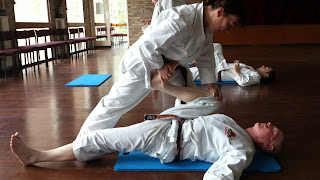Distance and timing........Mawashi-Geri
This brief article has come about due to yesterdays stretching session, where I was asked to go through one of Karate's most stylish of kicks, which can often be difficult to achieve without being subtle in terms of flexibility.
The club does push the values of stretching, where the club can evidence the values of one or two person stretching where you can achieve far more than by doing this alone.
From that point, the bag (which was being held in place) began to move to allow Karateka to chase the target, where distance and timing became even more critical.
Once this had been addressed we looked at what options you would have if you were out of distance (Run away should always be considered) and what options would you have if you were too close to your target.
This caused an interesting debate of creating distance by pushing away your opponent, kicking low to the legs to immobilise, kicking off the front leg, using a knee strike or your shin to strike your opponent.
What we all forget is that situations change rapidly in conflict where you will have to adapt your strategy without thinking about it. This is where the Kihon of the Mawashi-Geri assists you greatly as you will with muscle memory raise your knee to the target instinctively and project a strike to the moving target with either your foot, shin or knee. which ever way the technique is the same which can be adapted at that time to suit the change in distance and timing of your attacker.
What we are talking about here is one kick and nothing more during that mornings session. However you may change your offensive to a different kick such as Mae Geri as we found that morning, or use any other technique from the Shotokan system to deal with the ever changing distance and timing that is presented to you.
Kihon (Basics) will assist you if you did find yourself in this dangerous position, as after time in practicing Kihon you would naturally react to a given situation without the time for thought.
Kev Berry
The club does push the values of stretching, where the club can evidence the values of one or two person stretching where you can achieve far more than by doing this alone.
 |
| One person assisted stretching- Sensei's Mich and Dave. |
Sensei Dave took the session through various appropriate stretches for the remainder of the session which was going to focus on Mawashi-Geri.
Once Dave's thirty minute session was completed, I was asked to take the class through the Kihon of the Mawashi-Geri, where the emphasis was and always will be in correct Knee pick up, ankle elevation, supporting leg bent at the knee to assist projection with supporting foot turning as the kick is applied.
It was equally important as we all know after completing the kick to immediately bring the foot back to the pre-strike position as we may have to apply it once again and also for other reasons.
The Kihon quickly moved onto line training with a bag, where distance for executing a good Mawashi-Geri is paramount.
After kicking the bag on both legs at a slow speed to perfect the motion of the kick, Karateka then attacked the bag with speed and the desired amount of impact as if their life depended on it.
 |
| Two person assisted stretching which are all undertaken under controlled circumstances to prevent injury |
From that point, the bag (which was being held in place) began to move to allow Karateka to chase the target, where distance and timing became even more critical.
Once this had been addressed we looked at what options you would have if you were out of distance (Run away should always be considered) and what options would you have if you were too close to your target.
This caused an interesting debate of creating distance by pushing away your opponent, kicking low to the legs to immobilise, kicking off the front leg, using a knee strike or your shin to strike your opponent.
What we all forget is that situations change rapidly in conflict where you will have to adapt your strategy without thinking about it. This is where the Kihon of the Mawashi-Geri assists you greatly as you will with muscle memory raise your knee to the target instinctively and project a strike to the moving target with either your foot, shin or knee. which ever way the technique is the same which can be adapted at that time to suit the change in distance and timing of your attacker.
What we are talking about here is one kick and nothing more during that mornings session. However you may change your offensive to a different kick such as Mae Geri as we found that morning, or use any other technique from the Shotokan system to deal with the ever changing distance and timing that is presented to you.
Kihon (Basics) will assist you if you did find yourself in this dangerous position, as after time in practicing Kihon you would naturally react to a given situation without the time for thought.
Kev Berry



Comments
Post a Comment